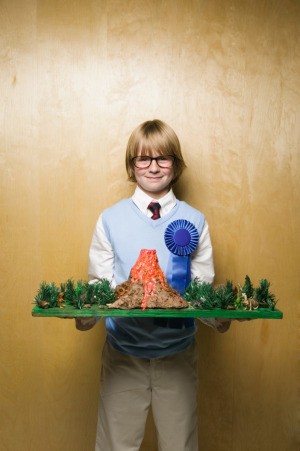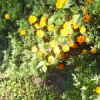
Place a lump of coal in bowl and sprinkle 1 Tbsp. salt over the coal. Carefully pour 2 Tbsp. water over salt. In the same manner, pour 2 Tbsp. of laundry bluing. Then add 2 or 3 drops of mercurochrome. Repeat with food coloring. After several days, you should have a colorful mosslike growth. If not, add a few more drops of water. This is something small children really enjoy!
By Robin from Washington, IA
Baking soda and vinegar make a dramatic foaming volcano to make with your kids. Save a party hat for the classic cone shape or make one yourself.
This is a page about mysteries of makeup science project. An interesting project for a school science fair can be created focusing on makeup, its science, a bit of history, safety standards, and more.
This is a page about blowing up a balloon with baking soda and vinegar. The chemical reaction that takes place when you mix baking soda and vinegar can be used to blow up a balloon.
This is a page about watermelon dry ice explosion. Try this fun science experiment with your older children. It is sure to be a hit.
Is there a way to make a really cool thing to demonstrate how bread rises?
By Sarah from Ireland

A Yeast Bread lecture and demonstration preparing loaf bread, one of the classes of yeast breads with a lab having the students prepare their own Loaf Bread following the techniques and skills of bread making.
Yeast Bread Study Sheet
Information of Yeast Breads
Cool Rise White Bread
Lab Planning SheetYeast Bread Recipes
Bread Home Assignment
Ingredients needed for demonstration and for each unit to prepare Cool Rise White Bread:
3 1/2 cups flour
1 tbs. yeast
1/2 tsp. sugar
1/4 cup warm water
7/8 cup milk
1 tbs. sugar
1 1/2 tsp. salt
1 1/2 tbs. margarine or shortening
cooking oil
masking tape
Ingredients for yeast experiment:
3 small custard cups
3 tbs. yeast
3 tsp. sugar
hot water
warm water
cold water with ice cubes
Attachments
Lab_Planning_Sheet.jpg
Yeast_Bread_Study_Sheet.doc
Yeast_Bread_Study_Sheet_Key.doc
Information_on_Yeast_Breads.doc
Cool_Rise_White_Bread.doc
Yeast_Bread_Recipes.doc
Home_Assignment_Form.doc
Lab_Planning_Sheet.pdf
Yeast_Bread_Study_Sheet.pdf
Yeast_Bread_Study_Sheet_KEY.pdf
Information_on_Yeast_Breads.pdf
Cool_Rise_White_Bread.pdf
Background For Teachers:
The teacher needs to have a basic understanding about yeast breads; the characteristics that identify them; how to prepare them using different methods; identify and know how to prepare the three classes of yeast breads - loafs, rolls, and deep-fat fried; identify the basic ingredients and their functions; know words like leavening, proofing, rising, ripe test, carbon dioxide as they pertain to yeast breads.
This demonstration and lab will take the students through all of the steps during class to prepare a loaf of bread as the bread rises in the refrigerator for up to 48 hours. It is baked the following class period.
Because it is a cool rise bread, it contains more yeast than a regular bread recipe for one loaf of bread. Some of the students may think this bread tastes a little yeasty, but they will devour it anyway. It is an excellent recipe for the students to see how to make loaf bread during a class period.
You will need to watch the time very closely to lecture, demonstrate and have the students complete their lab. It could be done in two days.
Student Prior Knowledge:
The student needs to know what yeast breads are and how they differ from quick breads. They should know how to prepare different yeast breads using different methods and what ingredients are used in the making of yeast breads.
Intended Learning Outcomes:
The student should be able to identify the characteristics and ingredients used in yeast breads from quick breads, and how to prepare them as rolls, loaf breads or deep-fat fried.
Instructional Procedures:
Hand out the Bread Home Assignment and the Yeast Bread Recipes. The recipes contain several bread recipes that may be used for their home assignment. Some of the other recipes are my favorites and some will be used in later labs.
There will be two home assignments for this yeast bread unit. One will be to prepare some homemade bread at home and the other to prepare rolls that will be given at a later date. The students can prepare one of the recipes in the packet or one that their family prefers. The student needs to bring the paper signed, identify the recipe used and attach a slice of bread for credit. It will be due the day of the test.
Go over the recipes in the packet to identify the ingredients, time it takes to prepare and how many loaves each recipe will make. I tell the students that they need to prepare the bread at home and not use a bread machine. I want them to mix the ingredients together, knead the dough, let it rise, shape the bread in a bread pan, let it rise again and bake it for credit.
Hand out the Yeast Bread Study Sheet, Information on Yeast Breads and recipe for Cool Rise White Bread.
Lecture on Yeast Breads as you demonstrate preparing the Cool Rise White Bread for the class. Use the study sheet as a guide.
Talk about the differences between Quick Breads and Yeast Breads.
What is yeast? Show the importance of the temperature of the water through an experiment. Have three custard cups on the countertop with three different temperatures of water - Warm water, cold water that has had ice cubes in it and hot water that has been heated in the microwave. Sprinkle in some yeast and sugar, stir and have the students observe during the lab the changes that occur. Discuss these with the class on the importance of the temperature of the water.
Demonstration: Prepare the recipe for the Cool Rise White Bread explaining and going through the steps. While kneading the dough, talk about the ingredients, their functions, the nutritional value of bread, classes, etc. After the dough is kneaded sufficiently, let the dough rest.
Lab: The students will quickly prepare the recipe for the Cool Rise White Bread as it was demonstrated in class. When they are kneading the dough, I like every student to have an opportunity to practice kneading the dough. If there are four students in the unit, each student needs to knead the dough for 2 - 2 1/2 minutes each. After their dough is kneaded, let it rest.
Demonstration: Have the students watch how you shape the dough while their dough is resting. If the students want to make Cinnamon Swirl with their dough I will show them how to do it. Once the dough is rolled out into a rectangle, lightly spread some water on the top, sprinkle with sugar and cinnamon. Continue to shape according to directions. Put shaped loaf into bread pan. Brush oil on the top and cover with saran wrap and label dough.
Lab: Students will go back to their units and shape their dough. Put it in the bread pan, cover with saran wrap and labeled and put in the refrigerator to rise until next class period.
Allow enough time for the students to complete lab and demonstration. Make sure the units are clean before they leave, especially the countertops. Good luck.
Hello, How about this? Hollow out a loaf of already baked bread and then insert a balloon. ( I would use an oblong balloon) The middle of the loaf will fall just a little, but you can insert the balloon and blow it up to demonstrate how the process works? Good luck, this was just a thought.
I am looking for a website that has quality, low cost (or free using stuff at home) easy science projects and/or experiments for a first or second grader. Any recommendations? Thanks.
By mindy
I am looking for some good Science Fair project ideas.
By jazz
Not knowing your age or your mechanical ability this could be challenging. You can go chemical and build a volcano and use chemicals to make it explode. You can go electronic and make a crystal radio.
If your a programmer you can write a program that takes a set of numbers and gives you the character set equivalent I.E. here is a random phone number 626-8147 it could spell.
m a m t 1 g p
n b n u 1 h r
o c b v 1 i s
hmmm... doesn't spell anything, bad example but still a good idea.
You could make and explain a water clock.
You could make and explain a fulcrum and give examples of how fulcrums are used today.
Give me more details about you and the science fair and I can probably come up with a lot more ideas. I time period would help too.
I'm looking for simple science projects for preschoolers.
Jean from Midway, PA
Preschoolers love to watch things grow. Take a zip type storage or freezer bag, put a moist paper towel inside and place a couple of the large lima beans in with the towel, Seal it and tape to a window or on a wall where the sun will shine on it. Watch it root.
Another good one is to put colored water in a container and a cut flower. In a day or two the flower will take on the color of the water.
Preschoolers love to watch things grow.
Place a moist paper towel in a zipper freezer bag with a few lima beans. seal it and place in a window or hang on a wall where the sun shines in and in a few days time it will begin to sprout.
Colored water in a clear glass conrainer with cut flowers (white or yellow work best) ... In a day or two they will start to streak with the colored water. Little kids love it!
Mine loved some of these hope they help:
Grow hair, have the parents send an egg to school, chip off some of the top fill with soil sprinkle with grass seed and place in egg carton that the top has been removed from have the kids put a face on the egg and wait the for the hair to grow.
Sweet potatoe vine is always a good one.
tn.essortment.com/
www.suite101.com/
Here are a couple of places for more ideas. Have fun:)